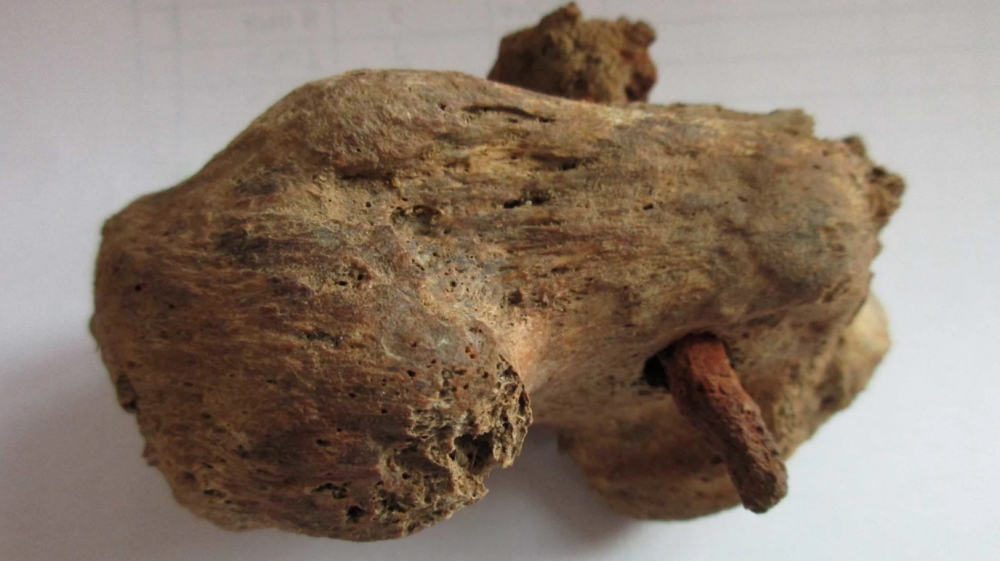Near the small town of Fenstanton in Cambridgeshire, England, a shocking discovery has been made. Archaeologists were called in ahead of some new housing developments and found evidence of ancient settlements. Upon wider investigation of a nearby area the remains of 48 individuals were found in 5 separate cemeteries, and most of them lived brutal lives. One man, however, was crucified and his remains are the only example of Roman crucifixion ever found in the UK.

The area around Fenstanton where the finds were unearthed once held a Dairy Crest bottling plant. Only when that became obsolete did the need for more housing spark an archaeological investigation. In 2017 researchers found a Roman settlement dating from the 1st century onward, possibly extending into the Anglo-Saxon period. Researchers from Albion Archaeology and Cambridge University have now published a paper on the site in British Archaeology magazine.
Along with the bones they found there was also pottery and evidence of extensive animal butchering, meaning this was an outpost settlement that perhaps took in off-cuts of meat that came from bigger cities. Signs of scraping on long bones of livestock as were found in large numbers- the type of second-market processing done on bones once the meat has been eaten. The marrow and fat from the bones could have been extracted for large quantities of soup or for cosmetics.
Despite the possibility that this could have been a military installation, there were males and females of all ages among the remains. The remains of four children were also discovered. One thing that the folks who lived there had in common was that they all had hard lives, the evidence visible in studying their bones today.

Many of the people who died there had dental problems, which is not uncommon for the era. About half the remains showed signs of cribra orbitalia, a bone deformity thought to be caused in some cases by malnutrition and malabsorption. It’s linked to iron deficiencies for these reasons and all but one of the those that showed signs of the disorder also showed signs of healing from it, meaning they had poor nutrition or diarrheal diseases as children. The authors of the study estimate that an outbreak of malaria could have been responsible for the high numbers of those with this bone deformity.
Many of the remains also showed signs of broken bones and poorly-healed fractures. Older people buried at the site showed signs of advanced and debilitating arthritis. Three of the people buried there suffered from Klippel-Feil syndrome, a congenital fusing fo the neck bones. But, the bones of one man, referred to as skeleton 4926, showed signs of trauma that stood out from the others.
This individual died between 210 CE and 360 CE at an age of between 25 and 35. He had 6 broken ribs consistent with being struck across the chest with a sword. He was buried with twelve iron nails surrounding his body. Some of these nails bore traces of oak which the authors suspect could have come from a wooden stretcher that had long since rotted away. His arms were folded downward with his hands covering his pelvis.
Once his remains were taken into the lab two things stood out. One was that his leg bones showed signs of wasting away as if he had been imprisoned and immobilized for a long period before his death. The other was that once his heel bones were examined a thirteenth nail was found struck through one of them and was still embedded in the bone, something that wasn’t immediately clear when his remains were first uncovered.

Unlike Christian iconography that often shows Jesus as being crucified with crossed ankles, Roman crucifixions often involved driving nails into the heels with the feet positioned on either side of the supporting post of the cross. This was to keep the victims from being able to move and adjust themselves to become more comfortable as they died. Many of the people the Romans crucified died of asphyxiation since the chest muscles and lungs experience fatal fatigue when a person is crucified with their arms out.
The Roman empire had outlawed crucifixion for Roman citizens in 212, except for very serious crimes. DNA analysis revealed that skeleton 4926 was a native to this area, furthering the likelihood that he might have been enslaved. He could have been found guilty of treason or another high crime regardless of whether he was a Roman citizen or not.
Only one other Roman crucifixion has been confirmed with human remains, a man who died in Israel in the 1st century. There have been no other examples of Roman crucifixion found in the UK. Despite his apparent crucifixion the man was buried in a respectful manner inconsistent with many of those were executed by the Romans, deepening the mystery of who he was.
SKM: below-content placeholderWhizzco for DOT

